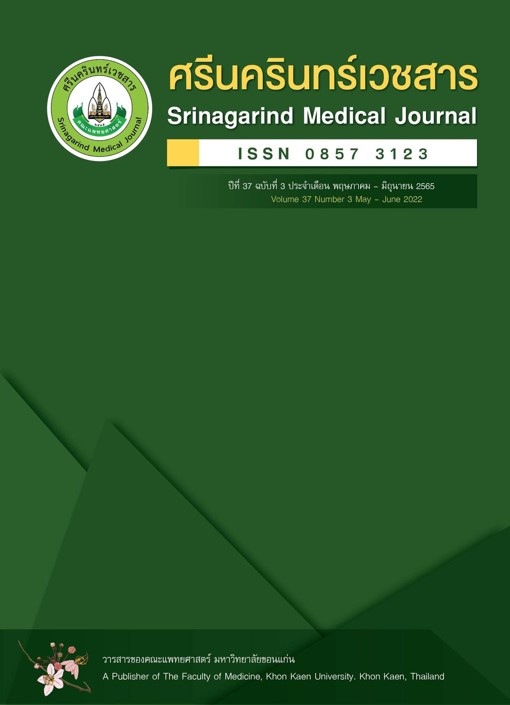Diffuse Alveolar Hemorrhage (DAH): Current Approach and Treatment
Abstract
ภาวะเลือดออกทั่วไปในถุงลมปอด: แนวทางปฏิบัติและการดูแลรักษาในปัจจุบัน
กุลธิดา รุจิสรรค์สกุล, วิภา รีชัยพิชิตกุล
สาขาวิชาโรคระบบการหายใจและภาวะวิกฤตระบบการหายใจ ภาควิชาอายุรศาสตร์ คณะแพทยศาสตร์ มหาวิทยาลัยขอนแก่น จังหวัดขอนแก่น
บทคัดย่อ
ภาวะเลือดออกทั่วไปในถุงลมปอดเป็นภาวะเร่งด่วนที่พบได้ไม่บ่อยแต่มีโอกาสเสียชีวิตสูง ผู้ป่วยจะมาพบแพทย์ด้วยไอเป็นเลือด โลหิตจาง ปื้นฝ้าขาวที่ปอด และภาวะหายใจล้มเหลวจากภาวะพร่องออกซิเจน อย่างไรก็ตามหนึ่งในสามของผู้ป่วยจะไม่มีอาการไอเป็นเลือด จึงจำเป็นต้องส่องกล้องหลอดลมและตรวจน้ำล้างปอดว่ามีสีแดงสดทั้ง 3 ขวดเพื่อการวินิจฉัย สาเหตุที่พบบ่อยที่สุดของภาวะเลือดออกทั่วไปในถุงลมปอดคือการอักเสบของหลอดเลือดฝอยที่ถุงลมปอด (capillaritis) จากภาวะ ANCA-associated vasculitis (เช่น granulomatosis with polyangiitis และ microscopic polyangiitis) และ connective tissue disease (เช่น systemic lupus erythematosus, SLE) โดยโรคกลุ่ม ANCA-associated vasculitis การรักษาคือ pulse methylprednisolone ร่วมกับ cyclophosphamide แล้วต่อด้วยการให้ immunosuppressive drugs มีการศึกษาการให้ rituximab ร่วมกับ pulse methylprednisolone ได้ผลในการหยุดเลือดใน ANCA-associated vasculitis ไม่แตกต่างจากการให้ cyclophosphamide ร่วมกับ pulse methylprednisolone ส่วน SLE ที่มาด้วยภาวะเลือดออกทั่วไปในถุงลมปอดตอบสนองดีต่อการรักษาด้วย high dose corticosteroid อย่างไรก็ตาม ผู้ป่วย SLE มีโอกาสที่จะติดเชื้อแบคทีเรียและเชื้อราร่วมด้วยสูง จึงแนะนำให้ยาปฏิชีวนะร่วมด้วยในระยะแรกของการรักษา โรค Anti-glomerular basement membrane disease เป็นโรคที่พบในกลุ่มภาวะเลือดออกทั่วไปในถุงลมปอดโดยไม่มีการอักเสบของหลอดเลือดฝอย (bland pulmonary hemorrhage) โรคนี้ตอบสนองต่อการทำ plasmapheresis เพื่อเอา anti-GBM antibodies ออกจากเลือด ร่วมกับการให้ pulse methylprednisolone ในกรณีที่เลือดออกในถุงลมปอดรุนแรงไม่ตอบสนองต่อการรักษาดังกล่าวในผู้ป่วย SLE และ Anti-glomerular basement membrane disease มีการใช้ rituximab หรือ recombinant-activated human factor VII ช่วยในการหยุดเลือด ถ้าเลือดออกทั่วไปในถุงลมปอดจากการทำลายทั่วไปของถุงลมปอด (diffuse alveolar damage, DAD) ซึ่งส่วนใหญ่มักเกิดจากการติดเชื้อ ให้รักษาสาเหตุร่วมกับให้การรักษาประคับประคองการหายใจและภาวะพร่องออกซิเจนด้วยเครื่องช่วยหายใจ
คำสำคัญ: ภาวะเลือดออกทั่วไปในถุงลมปอด, การรักษา
Abstract
Diffuse alveolar hemorrhage (DAH) is a rare life-threatening condition. The presentations are hemoptysis, anemia, diffuse lung infiltration, and acute hypoxemic respiratory failure. However, one-third of patients don’t have hemoptysis and need sequential bronchoalveolar lavage to demonstrate bleeding in 3 bottles of bronchoalveolar lavage fluids. The most common cause of DAH is capillaritis from ANCA-associated vasculitis (e.g., granulomatosis with polyangiitis and microscopic polyangiitis) and connective tissue disease (systemic lupus erythematosus, SLE). The treatment for ANCA-associated vasculitis is pulse methylprednisolone plus cyclophosphamide and maintenance with immunosuppressive drugs. The study showed rituximab plus pulse methylprednisolone was not inferior to cyclophosphamide plus pulse methylprednisolone for induction of remission in severe ANCA-associated vasculitis. For connective tissue disease (e.g., SLE) with DAH responded well with high dose corticosteroid, however precaution superinfection with bacteria and fungus and suggestion empirical antibiotic at initial. Anti-glomerular basement membrane disease is a cause in bland pulmonary hemorrhage group and the treatment is plasmapheresis to remove anti-GBM antibodies plus pulse methylprednisolone. In refractory DAH cases from SLE and Anti-glomerular basement membrane disease, rituximab and recombinant-activated human factor VII may be use to stop bleeding. If DAH from diffuse alveolar damage (DAD) usually from sepsis, treatment infection together with support ventilation and oxygenation.
Keyword: diffuse alveolar heworrhage, treatment


